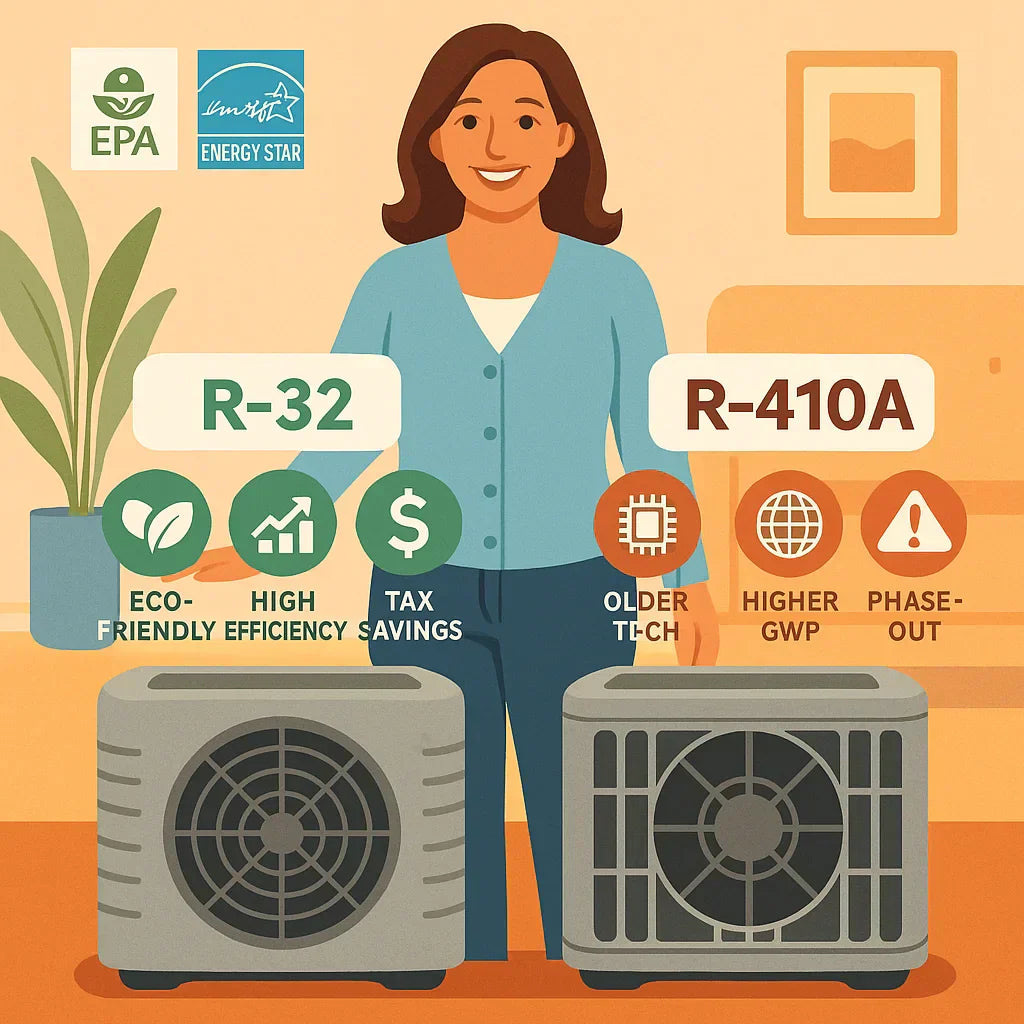A future-focused guide for homeowners choosing between today’s top refrigerants.
🔄 Introduction: The Refrigerant Shift Is Here
Whether you’re upgrading your air conditioning system or planning for a full HVAC replacement, one decision is more important than ever: which refrigerant will power your home’s cooling for the next 10–20 years?
For homeowners like Samantha Reyes, the choice often comes down to two options:
-
R-410A: The outgoing standard used for the past 20+ years
-
R-32: The rising global leader, now gaining traction in the U.S.
This article compares the two in plain terms so you can make a smart, eco-conscious, and future-ready decision.
📈 Quick Comparison Table
| Feature | R-410A | R-32 |
|---|---|---|
| GWP (Global Warming Potential) | 2,088 | 675 |
| Ozone Impact | None | None |
| Efficiency | Standard | 10–30% more efficient |
| Flammability Rating | A1 (non-flammable) | A2L (mildly flammable) |
| Availability (2025+) | Phasing out | Increasing adoption |
| Recyclability | Limited | High |
| System Charge Needed | Higher volume | Lower volume (~30%) |
| Installation Safety | Common practice | Requires A2L compliance |
🌍 Environmental Impact: R-32 Wins on GWP
❌ R-410A:
-
Global Warming Potential (GWP): 2,088
-
Not ozone-depleting, but contributes significantly to greenhouse gas emissions
-
Being phased out under the Kigali Amendment and the U.S. AIM Act
✅ R-32:
-
GWP: 675 (about 70% less than R-410A)
-
Already in use in over 100 million units worldwide
-
Recognized by the Environmental Protection Agency (EPA) as a safer, lower-impact alternative
Bottom line: If sustainability matters, R-32 is clearly the better choice.
⚡ Efficiency and Performance
R-410A:
-
Compatible with older AC designs
-
Meets older SEER standards (pre-2023)
-
Requires more refrigerant volume for the same cooling effect
R-32:
-
Transfers heat more efficiently
-
Enables higher SEER2 ratings
-
Supports smaller coils and compact unit designs
-
Consumes 10–30% less power in Energy Star-rated systems
Proof: Daikin reports R-32 units can reduce energy use by up to 10% compared to similar R-410A models.
🚫 Safety and Handling
🔒 R-410A:
-
Rated A1 (non-toxic, non-flammable)
-
Easy to install with standard tools
-
Does not require A2L-rated safety protocols
💡 R-32:
-
Rated A2L (low toxicity, mild flammability)
-
Safe in residential systems when installed by trained professionals
-
Requires:
-
Leak detection sensors
-
Ventilation awareness
-
A2L-compliant equipment
-
Note: ASHRAE confirms R-32’s safety in properly installed residential systems.
Takeaway: For safety-conscious homeowners, R-32 is safe—just make sure your installer is trained and certified.
💲 Cost Considerations
Upfront Costs:
-
R-410A units are still widely available and may cost slightly less
-
R-32 systems may have a small premium due to newer components and safety features
Long-Term Savings:
-
Lower refrigerant charge (less fluid = less cost to recharge)
-
Lower electricity usage = $150–400/year in savings depending on climate and usage
Example: Samantha’s home in North Carolina saw an average of $25/month savings during summer months after switching to R-32.
Also: R-32 systems often qualify for:
🔧 Service, Maintenance, and Repairs
R-410A:
-
Parts and servicing are still widely available
-
Easier to find experienced technicians
-
May soon be harder to source refrigerant after 2025
R-32:
-
Requires EPA Section 608-certified technicians with A2L training
-
Parts are becoming more widely available
-
Easier to recycle at end-of-life
Maintenance Tip: Schedule annual service with a technician familiar with R-32 systems and refrigerant safety.
🔄 Availability & Future-Proofing
R-410A:
-
Still sold in 2025, but many manufacturers are discontinuing production
-
Will become harder to find parts and compatible systems after 2030
R-32:
-
Already common globally (used by Daikin, Carrier, Goodman, LG, and more)
-
Meets 2025 U.S. efficiency and GWP standards
-
Will be supported for decades to come
Tip: Use AHRI Directory to verify which models are R-32 certified and SEER2-compliant.
🌟 Real-World Experience: Samantha’s Upgrade Story
Before:
-
12-year-old 3-ton R-410A system (SEER 13)
-
Cooling costs: $120–150/month in summer
After:
-
Installed Goodman 3-ton R-32 (SEER2 16.2)
-
Utility bills dropped by 22%
-
Claimed $2,000 federal tax credit + $500 utility rebate
Quote: “The savings were immediate, and I feel better knowing the system is aligned with future regulations.”
🔀 Final Comparison Summary
| Factor | Winner | Why |
| GWP/Environment | R-32 | 70% lower emissions |
| Efficiency | R-32 | Better heat transfer |
| Upfront Cost | R-410A | Slightly cheaper (for now) |
| Long-Term Value | R-32 | Lower utility bills + credits |
| Safety Simplicity | R-410A | No A2L rules to follow |
| Future-Proofing | R-32 | Long-term refrigerant access |
🤝 Conclusion: Which One Is Right for You?
If you want to save money, reduce your environmental impact, and stay ahead of HVAC regulation changes, R-32 is the smarter long-term choice.
That said, R-410A is still viable for those who need a budget-friendly option and are planning to upgrade again within 5–7 years.
For Samantha and many other forward-thinking homeowners, R-32 represents a smarter investment in comfort, compliance, and climate responsibility.
Next Step: Contact a certified HVAC contractor and ask if your next system is available with R-32 compatibility and SEER2 certification.
In the next topic we will kow more about: Is a 3-Ton R-32 AC System Right for Multi-Zone or Single-Zone Cooling?







